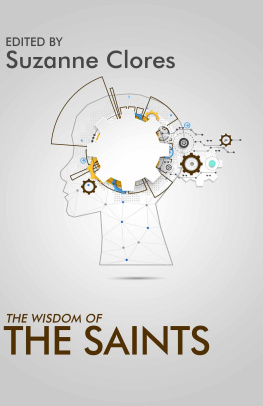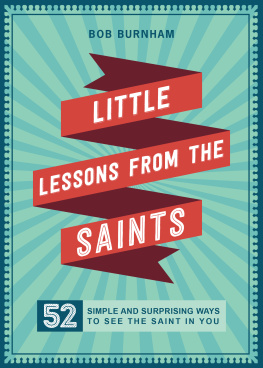BIOGRAPHICAL NOTES ON THE SOURCES
Saint Alphais
(?1211)
Alphais was born poor and spent her childhood in bed with leprosy, which possibly gave rise to her penitent nature and her commitment to holy work. While not much is known about her, she had enough of a public cult following to be named a saint.
Blessed Alphonsa of India
(19101946)
Alphonsa was generally sickly throughout her life and died young from stomach troubles. Known for her quiet nature, she taught grammar school and endeared herself to the children with her gentleness. Almost immediately upon her death, Alphonsa began appearing to children in visions. She is known as the patron saint of the sick.
Saint Alphonsus de Liguori
(16961787)
Alphonsus was a lawyer before he became a priest, bishop, and a then saint whose down-to-earth style and firm doctrine revealed themselves in his writings. He published Moral Theology in order to show Christians a middle route between rigor and laziness.
Saint Ambrose, Bishop of Milan
(340397)
Ambrose won the vote for Bishop much to his own surprise, but soon rose to the occasion by divesting himself of his wealth and parlaying his previous love for the law into administrating and preaching Christianity. Loved and esteemed by many, Ambroses powerful and compelling version of the teachings of Christ converted Saint Augustine of Hippo.
Angela of Foligno
(12481309)
Angela married a wealthy man and reveled in material possessions and a pleasure-seeking life before experiencing an about-face and committing to a life of poverty. At age thirty-seven, Angela modeled herself after Saint Francis of Assisi, divesting herself of her possessions, making a pilgrimage to Assisi, and hoping to meet Christ in the poor. Her writings include The Book of Divine Consolations of the Blessed Angela of Foligno and The Book of Visions and Instructions, both of which drew from her spiritual visions.
Father Annibale di Francia
(18511927)
Born in Sicily, a son of the Italian nobility, he was ordained a priest in 1878. In 1910, he traveled to Corato, Italy, where he began a seventeen-year series of visits and an intensely spiritual relationship with a young woman named Luisa, who frequently saw visions of Jesus and Mary. He founded the Rogationist Fathers of the Heart of Jesus and the Daughters of Divine Zeal, and in 1926 he was designated ecclesiastical censor for the united dioceses of Trani, Varletta, and Bisceglie.
Saint Anselm of Canterbury
(10331109)
Anselm grew up in an era of political and spiritual unrest; in the tenth century, the papacy was weak and emperors dominated. He was an outstanding philosopher and theologian, as well as a gentle and humble teacher in the monastery where he lived for forty-nine years. As the Archbishop of Canterbury, he inspired his monks and the society around them. Anselm is thought of as the more important Christian thinker between Saint Augustine and Saint Thomas Aquinas.
Augustine of Hippo
(354430)
Augustine became a renowned writer and teacher of Christian thought throughout Rome and North Africa, but not before battling his eras philosphical and academic skepticism towards the metaphysical. Struggling for three years, he eventually read the Holy Scriptures and listened to Saint Ambrose, both of which convinced him that Jesus Christ is the only way to truth and salvation. His Confessions describes his interior journey to God.
Saint Augustine of Canterbury
Roman monk (?ca. 606)
He brought Christianity to England in the sixth century and became the first archbishop of Canterbury. Augustine had lived a monastic life of work, prayer, and study of Scriptures. In response to Pope Gregorys directive to take the gospel message to the Anglo-Saxons, Augustine went to England and won the kings permission to convert all who would listen. His evangelization in southeastern England would grow throughout the entire British Isles.
Saint Basil the Great
(329379)
Basil was respected and loved for his aggressive attitude. At twenty-two he went to Athens for five years to further his liberal education, and there he met Gregory of Nazianzus, a fellow student, with whom he formed a lifelong friendship. He returned to his home state of Pontus and started a monastic community around his familys estate. Basil is known as the great because he successfully defended the freedom of the church from the greedy power of the state.
Saint Bede the Venerable
(673735)
Bede was raised in the Wearmouth Abbey and lived there his whole life. He was deeply committed to the church, believing it had the power to convert cultural violence, and took pleasure in writing, teaching, and study. He served as a priest, a Benedictine monk, teacher, and writer, translating the gospel of John and writing a history of the church, Historia Ecclesiastica. His writings started the idea of dating this era from the incarnation of Christ.
Bhagavad Gita
Ancient Hindu spiritual text written by an unknown saint of India between the fifth century B.C. and the first century A.D. The Bhagavad Gita, a single chapter of a larger work, the Mahabharata, is considered by Eastern and Western scholars alike to be among the worlds greatest spiritual books. In essence, it is a conversation between Lord Krishna and Arjuna framed in a battle story. Lord Krishna describes the science of self-realization and the exact process by which a human being can establish an eternal relationship with God.
Saint Bernard of Clairvaux
(10901153)
Saint Bernard joined the abbey of Citeaux at age twenty-two, along with his brothers and several friends looking for sanctuary from the world. He founded and led a Benedictine monastery at Clairvaux which became home to hundreds of monks. His religious work lay in politics, advising as well as admonishing the kings of France, helping to organize the second crusade, and helping to end the schism of antiPope Anacletus II.
Saint Birgitta
(ca. 13021373)
Birgitta began receiving visions, mostly of the Crucifixion, at age seven. Her mother, known for her piety, died c. 1315 when the girl was about twelve years old, and she was raised and educated by an equally pious aunt. She was arranged to marry a prince at age thirteen, becoming a princess and the mother of eight children, including Saint Catherine of Sweden. While married and a mother, she pursued her religious calling by becoming friend and counselor to many priests and theologians. When her husband died she returned to a more devout religious life, renouncing her title and recording the revelations given her in her visions, and these became hugely popular in the Middle Ages.
Saint Bonaventure
(12211274)
In his early twenties Bonaventure moved to Paris where he joined the Franciscan Order of Friars Minor and taught Franciscan theology. His early writings came from this period and established him as a leading authority on Franciscan thought, as well as changed the contemporary opinion that medieval theologians were dry rationalists. Many of Bonaventures writings delved deeply into spirituality.
Saint Boniface
(c. 673754)
Boniface was educated at the Benedictine monastery at Exeter in England. He was a missionary to Germany in 719, where there were only scattered centers of Christian influence. There is a story that when in Saxony, Boniface encountered a tribe worshipping a Norse deity in the form of a huge oak, reportedly six feet across. Boniface removed his shirt, picked up an axe, and without a word hacked down the tree. Never afraid to discuss his disappointment with church authorities, he died a martyrs death in Holland.











